I give a lot for science. Blood, sweat, tears, time. Heck, once I even had my arm caught in a large magnet filled with liquid helium (surprisingly terrifying). A couple of weeks ago may have taken the cake: I had to spend a week in southern Italy investigating the ruins left by the eruption of Mt. Vesuvius in AD 79. Rough life, right? Our financial austerity package still in effect following the travel binge of December/January, Sara didn't make this trip with me. And, to be clear, the week consisted mostly of work. My dreams of daily trips to Grom in Naples for gelato were thwarted (frankly, my dreams of
any gelato were thwarted), and sharing a bedroom with my colleague made it feel like science nerd-camp (which, honestly, it kind of was). That said, Italy is beautiful and seeing these cultural heritage sites in an up-close-and-personal, no-this-isn't-accessible-to-the-public-but-I'm-a-scientist-so-let-me-in way was phenomenal.
My week was spent in Herculaneum (Ercolano in Italian), a tiny town about 20-25 minutes south/southeast of Naples by train. Herculaneum is the less-loved sister of Pompeii, both destroyed by the eruption of Mt. Vesuvius in the first century AD. While the more-famous Pompeii was a more working-class city, Herculaneum was the Cannes of southern Italy: a place for the wealthy to go to their summer homes on the coast. According to Wikipedia, Herculaneum was initially founded in the sixth century BC, but came into full bloom in the first century BC under Roman control. In AD 62 there was an earthquake that did quite a lot of damage to the city, burying some buildings completely, but the residents stayed and started making repairs. In typical Italian fashion, the repairs took way too long and, seventeen years later, the population was destroyed by pyroclastic flows from Vesuvius. While Pompeii, somewhat further from the volcano than Herculaneum, was buried mostly by ash (and enough of it that it was truly buried), Herculaneum got nailed by volcano-hot flows of mud. It turns out that such hot mud is a perfect way to preserve a city: the structure remains mostly intact, but the water is immediately vaporized, nothing living (macro- or microorganisms) survives, and the mud hardens to form an air-and-watertight seal over the city. The ruins were discovered in the 17th century and have been excavated off-and-on since then, depending on finances. Currently, there are no active excavations because once the mud seals are broken, the decay kicks in rather quickly; the over-excavation of the 20th century has left too much of the city exposed to decay and not enough money to properly preserve it. They're trying to raise money to keep safe what they've already exposed before moving on (wise choice). In 1997, both Pompeii and Herculaneum were added (inscribed is their phrase) to the list of UNESCO World Heritage sites; their
website has lots of historical and otherwise cool info (and a great list of the coolest things in the world you should see).
 |
| View of Mt. Vesuvius from one of the streets in Herculaneum. |
On Sunday evening, following my arrival in Herculaneum, I took time to wander around the modern city a little bit. It didn't take long before I'd seen everything and knew my way around. The beach was terribly filthy, there were no restaurants open (and only five restaurants total, three of which were pizzerias), and the city was under a lot of construction. (At this point, I was pretty glad that we didn't spend the money for Sara to see such an ugly part of Italy.) The real magic began on Monday morning...
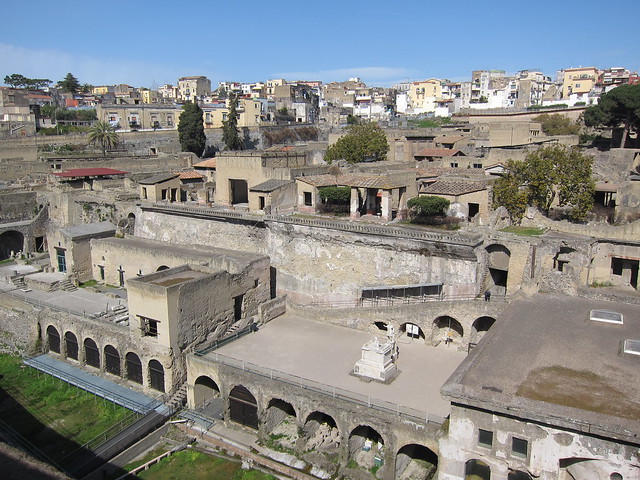 |
| This and the following two photos are views of the ancient city of Herculaneum from above. The little arch-shaped entries are boat launching places. People tried to hide in them following the eruption so they could make it out to sea. Turns out the pyroclastic flows were just too hot and their organic matter vaporized more or less instantly. During the excavation they found skeletal remains of many (hundreds?) of people, some in fetal, self-protecting stances. Crazy. I hear that some people did actually escape to sea, just not many. |
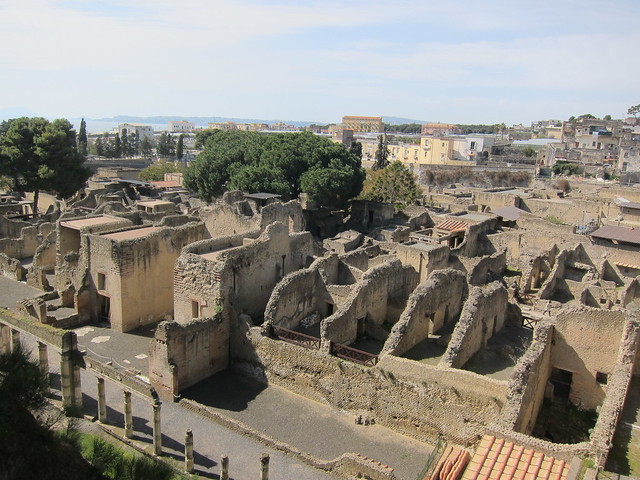

Herculaneum's setting is beautiful. The ruins are towards the beach
and, in fact, used to be right on the coastal cliffs, though the coast
has moved over the past two millennia. You enter from a gate at the
bottom of the modern city/top of the ancient one and have an overview of
the ancient city. It's really stunning. We walked along the side of the
city, around the back, and set up in the conservators'/restorers'
section, a few trailers converted into mobile offices in the back. We
got our all-access passes there, too, which made me feel awesome.
Our objectives were threefold: measure salt content in walls, measure
layer-by-layer profiles of fresco fragments that had fallen off of the
walls, and measure layer-by-layer profiles and water transport
properties in one particular area, the Villa of the Papyri. The first
day was dedicated to salt measurements, which didn't turn out very well
at all (and stress levels were getting too high for my tastes). On
Tuesday we started measuring fresco fragments, which turned out to be
extremely productive, and the rest of the data collection was
successful. (A scientific aside: measuring the frescoes will hopefully
help us develop a model for how the frescoes were created. Apparently,
certain pigments and certain techniques were used both before and after
the earthquake and, due to different costs of the two techniques, there
may have been economic reasons for one or the other. Some collaborators
measure the pigments, while we evaluate the technique for making the
frescoes by looking at the layer structure. I like to tell people that
the data always look incredibly boring, but it's made up for by the
beauty of the samples.)
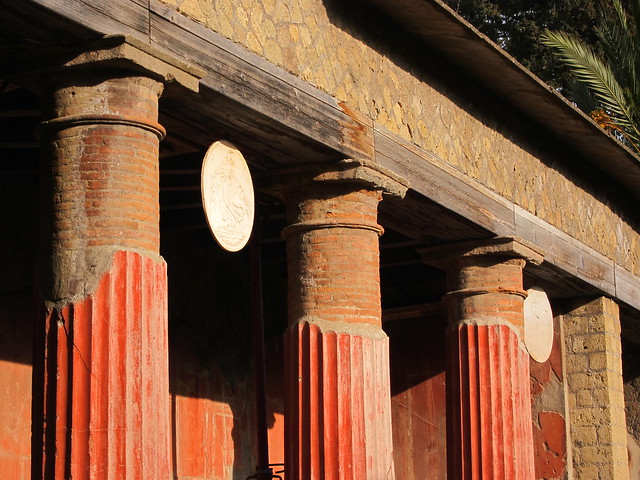 |
| Awesome columns, probably painted with cinnabar (also known as vermilion, or to this chemist, HgS). |
 |
| An entire BANK of clay ovens! Eat your hearts out fellow Agricolans! |
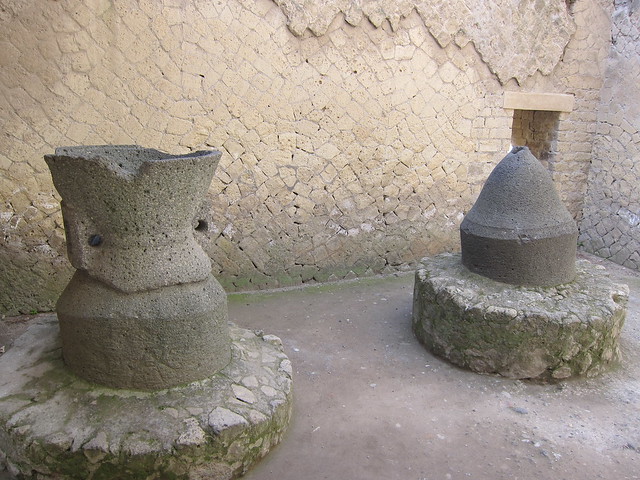 |
| The millstones used for prepping grain. |
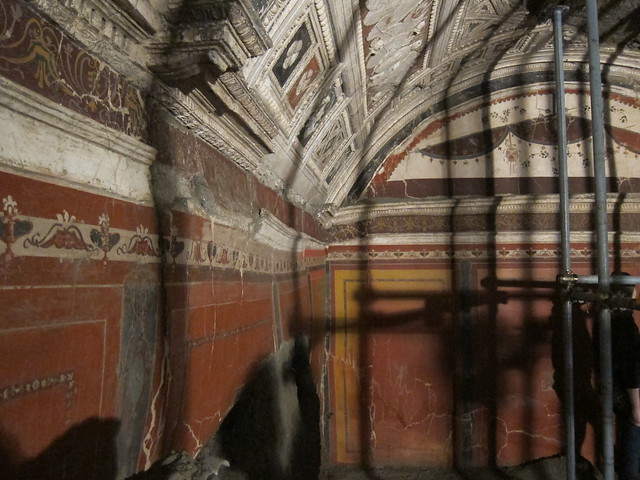 |
| Part of our all-access tour. This Villa of the Papyri isn't accessible to the public, due to the high rates of damage when its exposed to air. There were many (ca. 2000?) papyrus scrolls found here, some of the best relics of the ancient world. The scrolls are now in a library in Naples awaiting x-ray or other non-invasive techniques to decipher them without opening them. Opening up 2000+ year old scrolls, turns out, isn't a good idea. They break easily. |
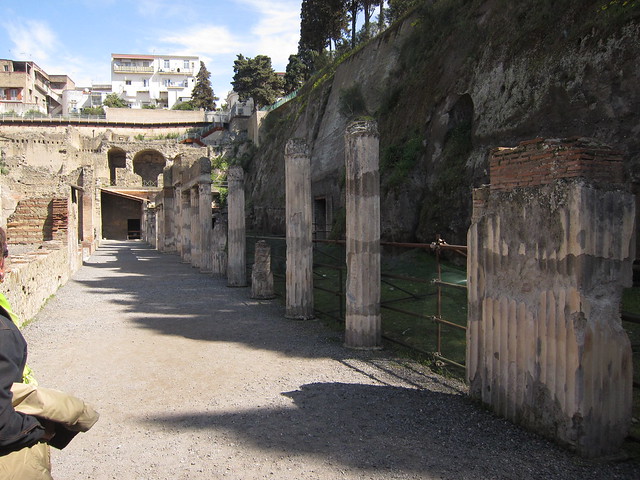 |
| A stroll down the promenade on the edge of the city. |
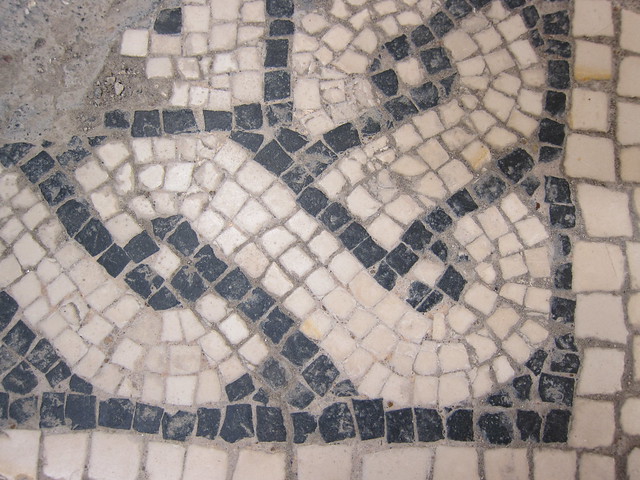 |
| A close up of the intricate tile work on the floors. |
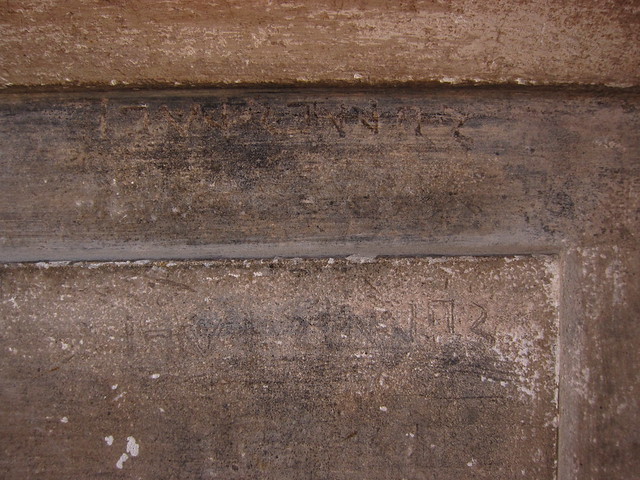 |
| This is an insider tip from the conservators: see the scribbling on the wall (two places)? That is ancient graffiti, most likely left by the Romans. Some things never change. |
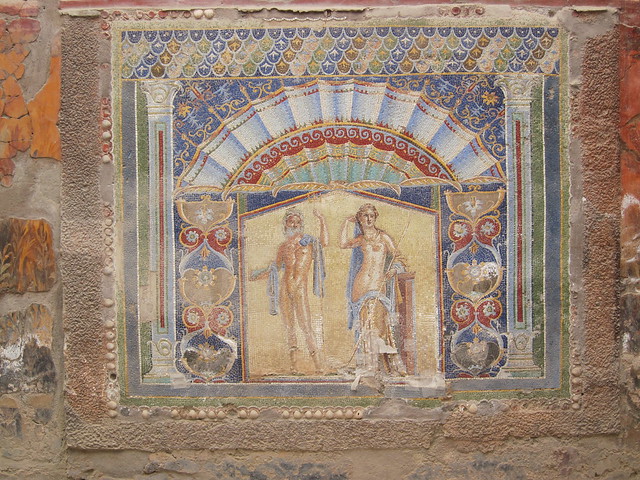 |
| One of the best preserved parts of the entire complex, the mosaic of Neptune and Amphitrite
is absolutely gorgeous. The colors are so vibrant (more than in this photo) and we, with our VIP badges, got to get right up and touch it. Almost. |
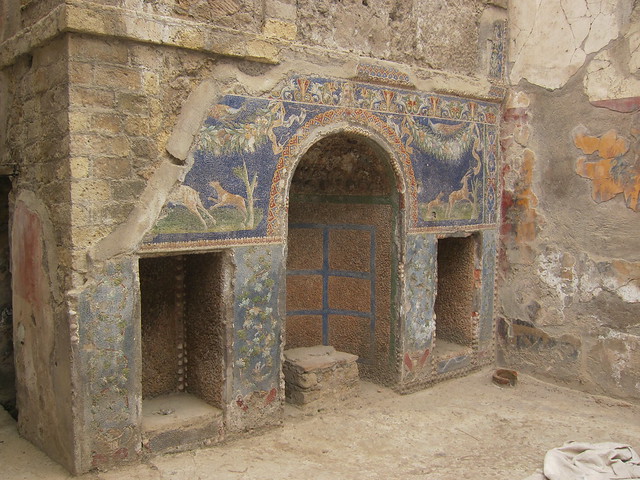 |
| This is the same room that has the Neptune and
Amphitrite
mosaic, only this is the wall on the left side. This used to be a garden room for a middle class family. They were middle class because they couldn't afford a plot of land for a real garden, so they decorated this room to look like a garden. I hope when I make it to the middle class I can get my entire living room covered in garden-esque mosaics. |
The rest of the trip pretty much followed the plan for Monday: walk down to the ancient city, make measurements, eat pizza for dinner, have nerdy conversations back at the room, and sleep. Depressingly, the food wasn't a highlight of the trip. That statement needs some qualification: in contrast to my trip to Florence in 2012, none of the food I had was the best of its particular culinary genre. And, as mentioned earlier, the restaurant choices were downright depressing. We ate at two restaurants twice each, and it was pizza for five of the six nights I was there (the non-pizza dish was just bad, so the pizza was pretty welcome). But, the pizza was really quite good, and the quantity and price were unbeatable. For lunches, we'd go into the public market every morning and by a few kilos of fruit, veggies, cheese, bread, and salami, then gorge ourselves on three or four pounds EACH on the morning's trappings. It was incredibly filling and really, really delicious. Though Sara would laugh at me every night when I recanted the day's lunch selections: 500 g strawberries, two large bell peppers, a loaf of bread, 200 g asiago cheese, 100 g salami, two pears, two apples, a banana (or two), three oranges, and (of course), a coke. That was Wednesday. Just for me. Yum. Oh, and two tomatoes.
We left Herculaneum on Saturday just before noon. However, I strong-armed the others into going to climb Mt. Vesuvius with me. (The other two with me had been to Herculaneum one and three prior times, yet they hadn't yet climbed the iconic volcano.) It was really cool. A 30 minute bus/van ride from Herculaneum to the base of the volcano trail, then a short yet steep 20 minute walk to the rim of the crater. It wasn't as amazing as I expected a volcano to be, but it was still neat. The crater is pretty large (a rough estimate from Google maps indicates maybe 1500-1800 feet in diameter?), with dirt in the bottom in which a few trees are growing (they're in for a surprise). You could see some volcanic steam coming up in a few places and generally walk around the top. To my surprise, I learned that, since the infamous eruption of 79, Vesuvius has erupted almost 40 times, the last time in 1944 when several (maybe ten?) people were killed. With that bit of knowledge, we bid arrivederci to the volcano and flew home. For those interested, there are many more photos on our
Flickr page, especially of the ruins of the city.
 |
| The crater of Mt. Vesuvius. Sara said that it looked really small at first. It's not. It's about 1500-1800 feet in diameter (almost a mile in circumference). |
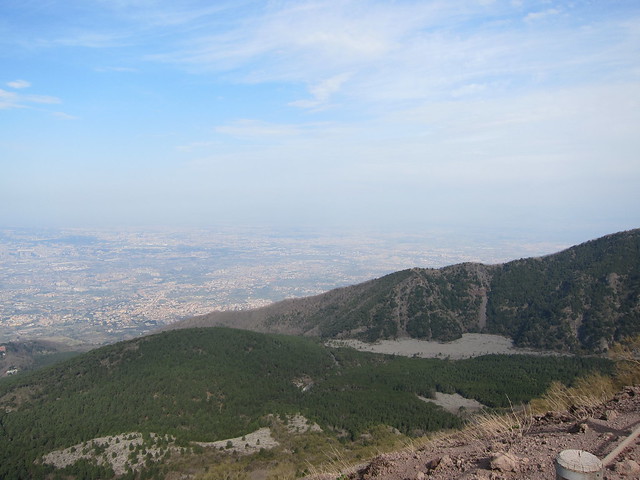 |
| A view out on the Bay of Naples and environs from the top of the volcano. |
 |
| The steam coming up from the volcano. "I don't know where I'm a gonna go when the volcano blow." --J. Buffett |
|
All this time in Italy makes me realize a few things. First, I love (what I perceive as) the Italian lifestyle: hanging out in the evening, eating late, talking with neighbors. I didn't even mind that it was dirty or small (though I'd need more restaurant options than Herculaneum has to offer). Second, it must be way more fun to be in Italy with someone awesome (e.g., Sara), rather than science-camp friends. With that in mind, we've scheduled more measurements in Italy (this time in Umbria, abutting Tuscany) in mid-May. And Sara is most decidedly coming this time. Rest assured you'll hear all about it.
P.S. The "Occupy Aachen" background you're seeing on the blog was some ironic hipster stencil graffiti (that is the technical term) I saw on an Aachen sidewalk a few weeks ago. Not exactly sure what you'd get if you were to occupy Aachen, but I wish them the best of luck.


















This is so exciting!!! As a child I was obsessed with Mount Vesuvius, Herculaneum and Pompeii. The red columns are the most stunning to me. I've always been told that Roman and Greek columns were colored, but I've never seen a picture... amazing.
ReplyDeleteAll I have to say about this is: "Grom. Now I understand."
ReplyDeleteSuper interesting, thanks, T. Wish I could puzzle out Vesuvius better from the tricky perspective in your pics. Great photos of the ruins. Love the clay ovens! How did you measure/ evaluate water transport through the layers?
ReplyDelete